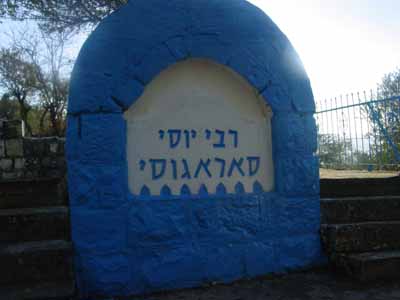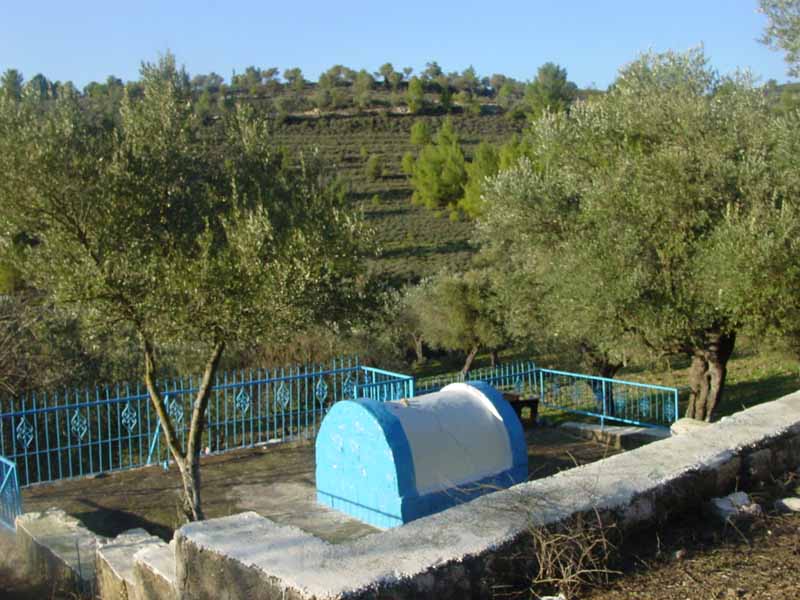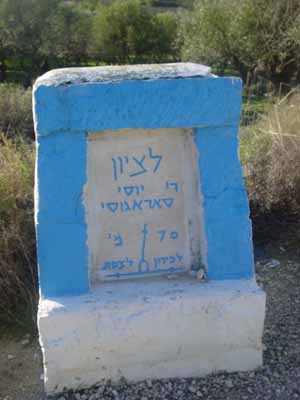“The Tzadik of the Hens”
by Chana Katz

It must have been quite a sight — dozens, maybe hundreds, of noisy roosters clucking and plucking their way down the Tsfat-Meron road to the gravesite of Rav Yossi Saragossi.
As if this spectacle in itself were not enough, someone sojourning this road some 400 years ago, would most certainly have done a double take: On the way out of Tsfat, the roosters were brown and black. But on the way back to Tsfat – – – they were pure white!
A miracle, completely above nature, had just occurred.
And the legend of the “Tzaddik HaLavan” (or the “saint of the roosters”) was born.
Sultan Blues
Life was never easy for the Jews in the Land of Israel after the Christians and the Muslims arrived, but there were times of peace and times of turbulence. One time of peace came under the leadership of Tsfat’s first recorded elected Chief Rabbi, Yossi Saragossi. His mild manners and esteem of peace and harmony earned him great respect, not only from the Jewish residents of the area, but neighboring Arab dwellers as well.
But some time after Rabbi Saragossi’s passing, a Sultan in the Ottoman Empire rose to power who made harsh decrees against the Jews of Tsfat. Under one such decree, they were ordered to deliver a large number of white roosters to the Sultan’s doorstep. It was an impossible demand since nowhere could so many white roosters be found.
The Jews of Tsfat fasted and prayed at the synagogue-burial site of Rav Yosi Bannai. One night, a member of the community said that Rabbi Saragossi had come to him in a dream.
Bring the roosters to my gravesite, R. Saragossi told him.
The next day they set out for the journey to R. Saragossi’s grave.
The procession down the road was filled with tension and an air of despair.
It is said that the miracle took place at the gravesite. The colored roosters became white as a fresh snow. One can only imagine the joy and awe that marked the return trip to Tsfat.
When the Sultan realized the great miracle that was done for the Jewish people, he swapped his harsh decrees for a course of respect.
And from that time on, R. Saragossi became know as the “Tzaddik of the Hens.” And to this very day, most locals in Tsfat still refer to the Shul of R. Yosi Bannai as the shul of the “Tzaddik HaLavan.”
The Hushed Valley of Olive Trees
One doesn’t need roosters today to visit the grave of R. Saragossi, who had raised Tsfat’s standing among the land of Israel’s cities and towns with his combination of Talmudic and Kabbalistic knowledge.
In fact, the solitude and serenity of R. Saragossi’s gravesite is alluring in itself.

It lies in a valley filled with olive trees overlooking the almost hypnotic peaks and valleys of the northern Galilee.
This is how to find the grave of R. Saragossi. After passing Meron, the resting place of Rabbi Shimon Bar Yochai, and winding around the curving incline toward Tsfat, you will pass — on the right side of the road — a lone building and plaza on a little hill which houses the gravesite of the esteemed Talmudic scholar, Rabbi Yehuda Bar Iloy. Soon after you round that bend, you can begin to look for a small marker on the right side of the road. If you look closely at the marker, it should show a map with arrows pointing to the grave of Rav Saragossi — 70 meters away.
Park your car on the side of the road and pass down some 20 steps bounded by a blue rail. Pass through a blue gate and walk straight down the dirt path. Looking up, you’ll see a canopy of trees, as if saluting in tribute to the great Jewish leader who lies ahead.
The grave is a clearly marked, rounded blue cement slab. It is encompassed by layered stone steps, which offer those who come to pray or meditate the serenity of unbridled nature. The gravesite of Rabbi Yehuda Bar Iloy, a large, two-story building, hovers over to the west in the direction of Meron.
Spain’s loss, Tsfat’s gain
If it weren’t for the Spanish Inquisition, Tsfat may never have received the likes of Rav Saragossi, who had been among the leaders of his community before being banished from Spain in 1492. But the hand of Providence pushed R. Saragossi to Sicily, Beirut and Sidon and then, finally, to the holy city of Tsfat.
While the Sephardic influence was minor in Jerusalem at the time, it was powerful in Tsfat and Rav Saragossi was quickly catapulted into the leadership role.
The Torah status of the Tsfat community flourished under Rav Saragossi, even catching the admiration of Jerusalmites to the south, with whom a rivalry of sorts both simmered and boiled over the centuries to come.
In one rabbinical dispute, Rav Saragossi and his colleague, Rav Peretz Colombo, made a ruling regarding whether the particular year, 1504, was a year of sh’mitta, a sabbatical year for the land. To the ire of the Jerusalem rabbis, who ruled otherwise, the opinion of the Tsfat rabbinate prevailed.
But for the most part, Torah learning and peaceful times prevailed under Rav Saragossi. It’s even recorded that at one point Rav Saragossi wanted to leave Tsfat for another city. The desire of the locals to keep him in Tsfat led to not only pleas for him to stay, but a nice annual wage as well — a majority of which was paid by the Arab governor of the city!
With the eventual succession of leadership from R. Saragossi to R. Yaakov Berav, the high standards of leadership were continued.
Then — NOW
Today, one doesn’t need to travel to the gravesite of Rav Saragossi with dozens of noisy roosters. But of course, sincere and heartfelt prayer to a Tzaddik can always change more than the color of feathers — even and maybe, especially — nowadays.
Chana Katz, a journalist from South Florida, lives in Tsfat with her husband and four children.

